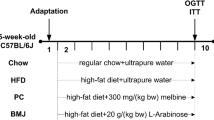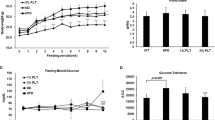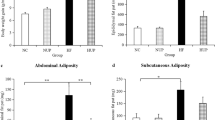Abstract
Purpose
Obesity has become a serious public health problem with its alarmingly increasing prevalence worldwide, prompting researchers to create and develop several anti-obesity drugs. Here, we aimed to investigate the protective effects of perilla seed oil (PSO), sunflower oil (SFO), and tea seed oil (TSO) against obesity through the modulation of the gut microbiota composition and related metabolic changes in mice fed a high-fat diet (HFD).
Methods
Mice were divided into six equal groups: ND (normal diet); HFD; ORL (HFD supplemented with 20 mg/kg body weight of orlistat); PSO, SFO, and TSO (HFD supplemented with 2 g/kg body weight of PSO, SFO, and TSO, respectively).
Results
Our findings showed that PSO, SFO, and TSO supplementation significantly reduced body weight, organ weight, blood glucose, lipopolysaccharides (LPS), insulin resistance, and improved serum lipid levels (TG, TC, LDL-C, and HDL-C). Meanwhile, the three treatments alleviated oxidative stress and hepatic steatosis and reduced liver lipid accumulation. Relative mRNA expression levels of inflammatory cytokines (TNF-α, IL-1β, IL-6, and MCP-1) and lipid synthesis-related genes (PPAR-γ, FAS, and SREBP-1) were down-regulated, while β-oxidation-related genes (PPAR-α, CPT1a, and CPT1b) were up-regulated in the liver tissue of treated mice. Besides, dietary oil supplementation alleviated HFD-induced gut microbiota dysbiosis by promoting gut microbiota richness and diversity, decreasing the Firmicutes-to-Bacteroidetes ratio, and boosting the abundance of some healthy bacteria, like Akkermansia.
Conclusions
PSO, SFO, and TSO supplementation could alleviate inflammation, oxidative stress, and hepatic steatosis, likely by modulating the gut microbiota composition in HFD-fed mice.









Similar content being viewed by others
Data availability
All data generated in this study are contained within the article or supplementary material file.
Abbreviations
- ALA:
-
Alpha-linolenic acid
- CPT1a:
-
Carnitine palmitoyl transferase 1a
- CPT1b:
-
Carnitine palmitoyl transferase 1b
- CVD:
-
Cardiovascular disease
- DHA:
-
Docosahexaenoic acid
- EPA:
-
Eicosapentaenoic acid
- FAS:
-
Fatty acid synthase
- F/B ratio:
-
Firmicutes-to-Bacteroidetes ratio
- LA:
-
Linoleic acid
- LPS:
-
Lipopolysaccharides
- MDA:
-
Malondialdehyde
- OA:
-
Oleic acid
- ORL:
-
Orlistat
- PPAR-α:
-
Peroxisome proliferator-activated receptor alpha
- PPAR-γ:
-
Peroxisome proliferator-activated receptor gamma
- PSO:
-
Perilla seed oil
- PUFA:
-
Polyunsaturated fatty acids
- qRT-PCR:
-
quantitative real-time reverse-transcription PCR
- SFA:
-
Saturated fatty acids
- SFO:
-
Sunflower oil
- SOD:
-
Superoxide dismutase
- SREBP-1:
-
Sterol regulatory element-binding transcription factor 1
- TSO:
-
Tea seed oil
- USFA:
-
Unsaturated fatty acids
References
Dibaise JK, Foxx-Orenstein AE (2013) Role of the gastroenterologist in managing obesity. Expert Rev Gastroenterol Hepatol 7:439–451. https://doi.org/10.1586/17474124.2013.811061
Yang M, Liu S, Zhang C (2022) The related metabolic diseases and treatments of obesity. Healthcare. https://doi.org/10.3390/healthcare10091616
Smith KB, Smith MS (2016) Obesity statistics. Prim Care 43(121–135):ix. https://doi.org/10.1016/j.pop.2015.10.001
Dragano NRV, Fernø J, Diéguez C, López M, Milbank E (2020) Recent updates on obesity treatments: available drugs and future directions. Neuroscience 437:215–239. https://doi.org/10.1016/j.neuroscience.2020.04.034
Hall KD, Farooqi IS, Friedman JM, Klein S, Loos RJF, Mangelsdorf DJ, O’Rahilly S, Ravussin E, Redman LM, Ryan DH et al (2022) The energy balance model of obesity: beyond calories in, calories out. Am J Clin Nutr 115:1243–1254. https://doi.org/10.1093/ajcn/nqac031%JTheAmericanJournalofClinicalNutrition
Thursby E, Juge N (2017) Introduction to the human gut microbiota. Biochem J 474:1823–1836. https://doi.org/10.1042/bcj20160510
Ke J, An Y, Cao B, Lang J, Wu N, Zhao D (2020) Orlistat-induced gut microbiota modification in obese mice. Evid-Based Complement Alternat Med eCAM 2020:9818349. https://doi.org/10.1155/2020/9818349
Gomes AC, Hoffmann C, Mota JF (2018) The human gut microbiota: metabolism and perspective in obesity. Gut Microb 9:308–325. https://doi.org/10.1080/19490976.2018.1465157
Canfora EE, Meex RCR, Venema K, Blaak EE (2019) Gut microbial metabolites in obesity, NAFLD and T2DM. Nat Rev Endocrinol 15:261–273. https://doi.org/10.1038/s41574-019-0156-z
Liu BN, Liu XT, Liang ZH, Wang JH (2021) Gut microbiota in obesity. World J Gastroenterol 27:3837–3850. https://doi.org/10.3748/wjg.v27.i25.3837
Turnbaugh PJ, Hamady M, Yatsunenko T, Cantarel BL, Duncan A, Ley RE, Sogin ML, Jones WJ, Roe BA, Affourtit JP et al (2009) A core gut microbiome in obese and lean twins. Nature 457:480–484. https://doi.org/10.1038/nature07540
Chang CJ, Lin CS, Lu CC, Martel J, Ko YF, Ojcius DM, Tseng SF, Wu TR, Chen YY, Young JD et al (2015) Ganoderma lucidum reduces obesity in mice by modulating the composition of the gut microbiota. Nat Commun 6:7489. https://doi.org/10.1038/ncomms8489
Remely M, Hippe B, Zanner J, Aumueller E, Brath H, Haslberger AG (2016) Gut microbiota of obese, type 2 diabetic individuals is enriched in Faecalibacterium prausnitzii, Akkermansia muciniphila and Peptostreptococcus anaerobius after weight loss. Endocr Metab Immune Disord Drug Targets 16:99–106. https://doi.org/10.2174/1871530316666160831093813
Thomas SS, Cha YS, Kim KA (2020) Effect of vegetable oils with different fatty acid composition on high-fat diet-induced obesity and colon inflammation. Nurs Res Pract 14:425–437. https://doi.org/10.4162/nrp.2020.14.5.425
Liao B, Hao Y, Lu J, Bai H, Guan L, Zhang T (2018) Transcriptomic analysis of Perilla frutescens seed to insight into the biosynthesis and metabolic of unsaturated fatty acids. BMC Genomics 19:213. https://doi.org/10.1186/s12864-018-4595-z
Lee AY, Choi JM, Lee MH, Lee J, Lee S, Cho EJ (2018) Protective effects of perilla oil and alpha linolenic acid on SH-SY5Y neuronal cell death induced by hydrogen peroxide. Nurs Res Pract 12:93–100. https://doi.org/10.4162/nrp.2018.12.2.93
Akrami A, Nikaein F, Babajafari S, Faghih S, Yarmohammadi H (2018) Comparison of the effects of flaxseed oil and sunflower seed oil consumption on serum glucose, lipid profile, blood pressure, and lipid peroxidation in patients with metabolic syndrome. J Clin Lipidol 12:70–77. https://doi.org/10.1016/j.jacl.2017.11.004
Cheng YT, Lu CC, Yen GC (2015) Beneficial effects of camellia oil (Camellia oleifera Abel.) on hepatoprotective and gastroprotective activities. J Nutr Sci Vitaminol 61(1):S100-102. https://doi.org/10.3177/jnsv.61.S100
Qu L, Liu Q, Zhang Q, Tuo X, Fan D, Deng J, Yang H (2019) Kiwifruit seed oil prevents obesity by regulating inflammation, thermogenesis, and gut microbiota in high-fat diet-induced obese C57BL/6 mice. Food Chem Toxicol Int J Publ Br Ind Biol Res Assoc 125:85–94. https://doi.org/10.1016/j.fct.2018.12.046
Huang T, Zhou W, Ma X, Jiang J, Zhang F, Zhou W, He H, Cui G (2021) Oral administration of camellia oil ameliorates obesity and modifies the gut microbiota composition in mice fed a high-fat diet. FEMS Microbiol Lett. https://doi.org/10.1093/femsle/fnab063
Reagan-Shaw S, Nihal M, Ahmad N (2008) Dose translation from animal to human studies revisited. FASEB J Off Publ Feder Am Soc Exp Biol 22:659–661. https://doi.org/10.1096/fj.07-9574LSF
Wang SS, Lay S, Yu HN, Shen SR (2016) Dietary Guidelines for Chinese Residents (2016): comments and comparisons. J Zhejiang Univ Sci B 17:649–656. https://doi.org/10.1631/jzus.B1600341
Deng Z, Meng C, Huang H, Song S, Fu L, Fu Z (2022) The different effects of psyllium husk and orlistat on weight control, the amelioration of hypercholesterolemia and non-alcohol fatty liver disease in obese mice induced by a high-fat diet. Food Funct. https://doi.org/10.1039/d2fo01161a
Qu L, Liu Q, Zhang Q, Liu D, Zhang C, Fan D, Deng J, Yang H (2019) Kiwifruit seed oil ameliorates inflammation and hepatic fat metabolism in high-fat diet-induced obese mice. J Funct Foods 52:715–723. https://doi.org/10.1016/j.jff.2018.12.003
Zhan J, Liang Y, Liu D, Ma X, Li P, Zhai W, Zhou Z, Wang P (2019) Pectin reduces environmental pollutant-induced obesity in mice through regulating gut microbiota: a case study of p, p′-DDE. Environ Int 130:104861
Yan L, Combs GF Jr (2014) Consumption of a high-fat diet abrogates inhibitory effects of methylseleninic acid on spontaneous metastasis of Lewis lung carcinoma in mice. Carcinogenesis 35:2308–2313. https://doi.org/10.1093/carcin/bgu153
Bhurosy T, Jeewon R (2014) Overweight and obesity epidemic in developing countries: a problem with diet, physical activity, or socioeconomic status? Sci World J 2014:964236. https://doi.org/10.1155/2014/964236
De Wit N, Derrien M, Bosch-Vermeulen H, Oosterink E, Keshtkar S, Duval C, de den Vogel-vanBosch J, Kleerebezem M, Müller M, van der Meer R (2012) Saturated fat stimulates obesity and hepatic steatosis and affects gut microbiota composition by an enhanced overflow of dietary fat to the distal intestine. Am J Physiol Gastrointest Liver Physiol 303:G589-599. https://doi.org/10.1152/ajpgi.00488.2011
Li J, Wu H, Liu Y, Yang L (2020) High fat diet induced obesity model using four strainsof mice: kunming, C57BL/6, BALB/c and ICR. Exp Anim 69:326–335. https://doi.org/10.1538/expanim.19-0148
Fu J, Wang B, Gong D, Zeng C, Jiang Y, Zeng Z (2015) Camphor tree seed kernel oil reduces body fat deposition and improves blood lipids in rats. J Food Sci 80:H1912-1917. https://doi.org/10.1111/1750-3841.12943
Fu J, Zeng C, Zeng Z, Wang B, Gong D (2016) Cinnamomum camphora seed kernel oil ameliorates oxidative stress and inflammation in diet-induced obese rats. J Food Sci 81:H1295-1300. https://doi.org/10.1111/1750-3841.13271
Aoki M, Murase T (2019) Obesity-associated insulin resistance adversely affects skin function. PloS ONE 14:e0223528. https://doi.org/10.1371/journal.pone.0223528
Su J, Ma C, Liu C, Gao C, Nie R, Wang H (2016) Hypolipidemic activity of peony seed oil rich in α-linolenic, is mediated through inhibition of lipogenesis and upregulation of fatty acid β-oxidation. J Food Sci 81:H1001-1009. https://doi.org/10.1111/1750-3841.13252
Pérez-Torres I, Castrejón-Téllez V, Soto ME, Rubio-Ruiz ME, Manzano-Pech L, Guarner-Lans V (2021) Oxidative stress, plant natural antioxidants, and obesity. Int J Mol Sci. https://doi.org/10.3390/ijms22041786
Tan BL, Norhaizan ME, Liew WP (2018) Nutrients and oxidative stress: friend or foe? Oxid Med Cell Longev 2018:9719584. https://doi.org/10.1155/2018/9719584
Liu QY, Wang YT, Lin LG (2015) New insights into the anti-obesity activity of xanthones from Garcinia mangostana. Food Funct 6:383–393. https://doi.org/10.1039/c4fo00758a
Williams KW, Scott MM, Elmquist JK (2009) From observation to experimentation: leptin action in the mediobasal hypothalamus. Am J Clin Nutr 89:985s–990s. https://doi.org/10.3945/ajcn.2008.26788D
Thomas SS, Kim M, Lee SJ, Cha YS (2018) Antiobesity effects of purple perilla (Perilla frutescens var. acuta) on adipocyte differentiation and mice fed a high-fat diet. J Food Sci 83:2384–2393. https://doi.org/10.1111/1750-3841.14288
Taouis M, Benomar Y (2021) Is resistin the master link between inflammation and inflammation-related chronic diseases? Mol Cell Endocrinol 533:111341. https://doi.org/10.1016/j.mce.2021.111341
Muccioli GG, Naslain D, Bäckhed F, Reigstad CS, Lambert DM, Delzenne NM, Cani PD (2010) The endocannabinoid system links gut microbiota to adipogenesis. Mol Syst Biol 6:392. https://doi.org/10.1038/msb.2010.46
Zhao L (2013) The gut microbiota and obesity: from correlation to causality. Nat Rev Microbiol 11:639–647. https://doi.org/10.1038/nrmicro3089
Wang Y, Nakajima T, Gonzalez FJ, Tanaka N (2020) PPARs as metabolic regulators in the liver: lessons from liver-specific PPAR-null mice. Int J Mol Sci. https://doi.org/10.3390/ijms21062061
Noratto G, Chew BP, Ivanov I (2016) Red raspberry decreases heart biomarkers of cardiac remodeling associated with oxidative and inflammatory stress in obese diabetic db/db mice. Food Funct 7:4944–4955. https://doi.org/10.1039/c6fo01330a
Shao W, Espenshade PJ (2012) Expanding roles for SREBP in metabolism. Cell Metab 16:414–419. https://doi.org/10.1016/j.cmet.2012.09.002
Kliewer SA, Xu HE, Lambert MH, Willson TM (2001) Peroxisome proliferator-activated receptors: from genes to physiology. Recent Prog Horm Res 56:239–263. https://doi.org/10.1210/rp.56.1.239
Aguanno D, Metwaly A, Coleman OI, Haller D (2022) Modeling microbiota-associated human diseases: from minimal models to complex systems. Microb Res Rep 1:17. https://doi.org/10.20517/mrr.2022.01
Ciobârcă D, Cătoi AF, Copăescu C, Miere D, Crișan G (2020) Bariatric surgery in obesity: effects on gut microbiota and micronutrient status. Nutrients. https://doi.org/10.3390/nu12010235
Perrio MJ, Wilton LV, Shakir SA (2007) The safety profiles of orlistat and sibutramine: results of prescription-event monitoring studies in England. Obesity 15:2712–2722. https://doi.org/10.1038/oby.2007.323
Porras D, Nistal E, Martínez-Flórez S, Pisonero-Vaquero S, Olcoz JL, Jover R, González-Gallego J, García-Mediavilla MV, Sánchez-Campos S (2017) Protective effect of quercetin on high-fat diet-induced non-alcoholic fatty liver disease in mice is mediated by modulating intestinal microbiota imbalance and related gut-liver axis activation. Free Radical Biol Med 102:188–202. https://doi.org/10.1016/j.freeradbiomed.2016.11.037
Bervoets L, Van Hoorenbeeck K, Kortleven I, Van Noten C, Hens N, Vael C, Goossens H, Desager KN, Vankerckhoven V (2013) Differences in gut microbiota composition between obese and lean children: a cross-sectional study. Gut Pathog 5:10. https://doi.org/10.1186/1757-4749-5-10
Million M, Thuny F, Angelakis E, Casalta JP, Giorgi R, Habib G, Raoult D (2013) Lactobacillus reuteri and Escherichia coli in the human gut microbiota may predict weight gain associated with vancomycin treatment. Nutr Diabetes 3:e87. https://doi.org/10.1038/nutd.2013.28
Shang Q, Song G, Zhang M, Shi J, Xu C, Hao J, Li G, Yu G (2017) Dietary fucoidan improves metabolic syndrome in association with increased Akkermansia population in the gut microbiota of high-fat diet-fed mice. J Funct Foods 28:138–146. https://doi.org/10.1016/j.jff.2016.11.002
Liu Z, Chen Z, Guo H, He D, Zhao H, Wang Z, Zhang W, Liao L, Zhang C, Ni L (2016) The modulatory effect of infusions of green tea, oolong tea, and black tea on gut microbiota in high-fat-induced obese mice. Food Funct 7:4869–4879. https://doi.org/10.1039/c6fo01439a
Chen G, Xie M, Dai Z, Wan P, Ye H, Zeng X, Sun Y (2018) Kudingcha and fuzhuan brick tea prevent obesity and modulate gut microbiota in high-fat diet fed mice. Mol Nutr Food Res 62:e1700485. https://doi.org/10.1002/mnfr.201700485
Le Chatelier E, Nielsen T, Qin J, Prifti E, Hildebrand F, Falony G, Almeida M, Arumugam M, Batto JM, Kennedy S et al (2013) Richness of human gut microbiome correlates with metabolic markers. Nature 500:541–546. https://doi.org/10.1038/nature12506
Sung MM, Kim TT, Denou E, Soltys CM, Hamza SM, Byrne NJ, Masson G, Park H, Wishart DS, Madsen KL et al (2017) Improved glucose homeostasis in obese mice treated with resveratrol is associated with alterations in the gut microbiome. Diabetes 66:418–425. https://doi.org/10.2337/db16-0680
Kong C, Gao R, Yan X, Huang L, Qin H (2019) Probiotics improve gut microbiota dysbiosis in obese mice fed a high-fat or high-sucrose diet. Nutrition 60:175–184. https://doi.org/10.1016/j.nut.2018.10.002
Dao MC, Everard A, Aron-Wisnewsky J, Sokolovska N, Prifti E, Verger EO, Kayser BD, Levenez F, Chilloux J, Hoyles L et al (2016) Akkermansia muciniphila and improved metabolic health during a dietary intervention in obesity: relationship with gut microbiome richness and ecology. Gut 65:426–436. https://doi.org/10.1136/gutjnl-2014-308778
Naito Y, Uchiyama K, Takagi T (2018) A next-generation beneficial microbe: Akkermansia muciniphila. J Clin Biochem Nutr 63:33–35. https://doi.org/10.3164/jcbn.18-57
Chen M, Liao Z, Lu B, Wang M, Lin L, Zhang S, Li Y, Liu D, Liao Q, Xie Z (2018) Huang-Lian-Jie-Du-decoction ameliorates hyperglycemia and insulin resistant in association with gut microbiota modulation. Front Microbiol 9:2380. https://doi.org/10.3389/fmicb.2018.02380
Funding
This work was supported by the Chongqing Modern Mountainous Characteristic Efficient Agricultural Industrial Technology System (Innovation Team No. 2021 [4]); Key R&D projects of Sichuan Science and Technology Plan (2020YFN0148).
Author information
Authors and Affiliations
Contributions
WA: conceived and designed experiments, performed the majority of the experiments, data analysis, and wrote the manuscript. HT and DL: contributed to reagents, materials, data curation, methodology, and software. HM and ZY: contributed to experiments, investigation, methodology, and data curation. GZ: conceived and designed the experiments, supervised the study, and checked and submitted the final manuscript.
Corresponding author
Ethics declarations
Conflict of interest
The authors have no relevant financial or non-financial interests to disclose.
Ethics approval
The animal experiment protocol was supervised and approved by the Institutional Animal Care and Use Committee of Southwest University (IACUC No. Approved IACUC-20210225-06).
Supplementary Information
Below is the link to the electronic supplementary material.
Rights and permissions
Springer Nature or its licensor (e.g. a society or other partner) holds exclusive rights to this article under a publishing agreement with the author(s) or other rightsholder(s); author self-archiving of the accepted manuscript version of this article is solely governed by the terms of such publishing agreement and applicable law.
About this article
Cite this article
Aldamarany, W.A.S., Taocui, H., Liling, D. et al. Perilla, sunflower, and tea seed oils as potential dietary supplements with anti-obesity effects by modulating the gut microbiota composition in mice fed a high-fat diet. Eur J Nutr 62, 2509–2525 (2023). https://doi.org/10.1007/s00394-023-03155-3
Received:
Accepted:
Published:
Issue Date:
DOI: https://doi.org/10.1007/s00394-023-03155-3




